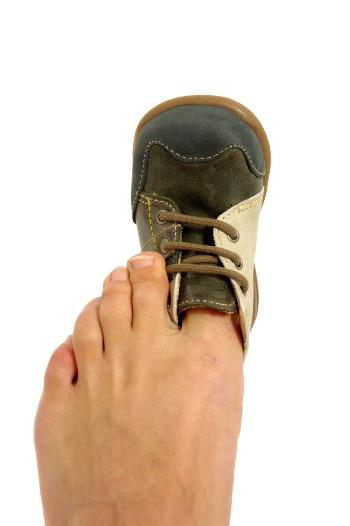It's just too small
Duration/age

The weather has changed and it’s time to see if last year’s clothing still fits.
Summer has finally ended and the nights are getting cold. I think it is time to change to winter pyjamas. We will have to see if last year’s still fit.
Talk with your child about the different ways you can work out if their clothing will fit. Do they need to try it on? Can you just hold it up against them to see if it is still big enough?
When I hold your long pants against you I can see they are too short. We will have to buy you the next size up.
Sit with your child and sort the clothing into what still fits and what doesn’t. Once you are done, talk to your child about how you know what size to buy. Will you take them to the shop so they can try on the different items of clothing? Do you look at the label on last year’s clothes and buy the next size up?
The label in your jumper says it is a size 4. I think we will have to buy 2 sizes bigger as you have grown so much. When we get to the shop we will need to look for the jumpers that are size 6.
You can talk about what you will do with your child’s clothing now it doesn’t fit. Will it fit a younger child in your family? Do any of your family or friends have a child who could wear the clothes?
Your winter coat will fit Ben this year. The sleeves will be too long but we can roll them up.
Materials you will need
- Clothing
- Clothing labels
Alternative tools
- Shops
Skills this activity improves
Why does this matter?
When you talk to your child about their clothing being too small you are helping them to learn about measurement, size and the different ways we can describe and compare measurement.
As you talk about how much they have grown and we try to predict if last year’s clothing will still fit you are using language to describe the attributes of size. Size can be described or measured using a number, a measuring tool or by trying to fit an object inside of another one.
When you talk to your child about the labels on their clothes they will be learning that writing and symbols carry meaning. Sometimes the label will help us to know the size of the garment or how to wash it. You will be showing your child that numbers and symbols also contain meaning and that we can use a symbol instead of a word.
What does this lead to?
Exploring the different ways we can measure objects encourages children to problem-solve and to notice similarities and differences. When children can identify what is the same about an object they begin to generalise solutions and strategies from one event to another. This is the beginning of problem-solving.
As children notice the different colours, shapes, images and how the image is placed on the label they are developing an understanding that pictures and symbols can tell a story. As your child grows older, understanding the different ways language can be presented will help them to make decisions on how to organise or record their thinking.
Language to use
- Size, fit, measurement
- Height, length, width
- Small, medium, large, bigger, smaller
- Clothing, garment
- Growing, grown, growth, expand
- Same, different, compare
- Label
Questions to use
- Can you still wear your winter pyjamas if the legs are too short?
- When do long pants become shorts?
- Why do some clothes stretch?
Useful tips
- You might also like to take a look at the activities How tall am I? and Sorting the washing ready to wash.
- Remember to talk to your child in your home language.
More ideas
Create a height chart on the wall.
Variation by age
Birth to two year olds
- Set up a height chart for all the family.
- Trace around different parts of your body and compare which is bigger, which is smaller.
- Trace around your hands and feet. Cut out the tracings and use them as measuring tools.
Three to five year olds
- Set up a height chart for all the family.
- Trace around different parts of your body and compare which is bigger, which is smaller.
- Google the heights or lengths of different animals. Use string to measure the sizes out on the ground and compare the sizes to your child.
- Set up a measuring toolbox with rulers, tape measures and string for measuring.
Questions to ask
- Who is the biggest in our family?
- Who is the smallest in our family?
- How many cut-out feet long is the verandah?
- How many cut-out hands tall is the fridge?
Questions to ask
- What tool can you use to measure height with?
- How many cut-out hands tall is the wall?
- Which is bigger, the dog or the elephant?
- How many cut-out feet long is the driveway?


